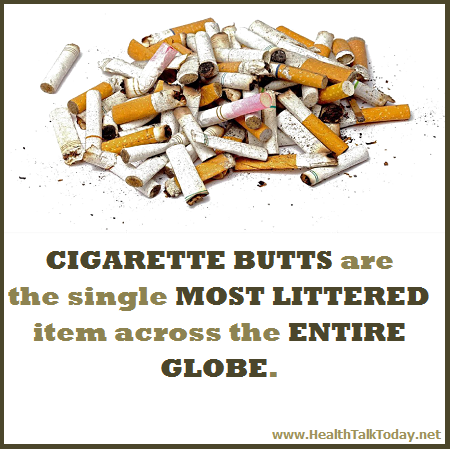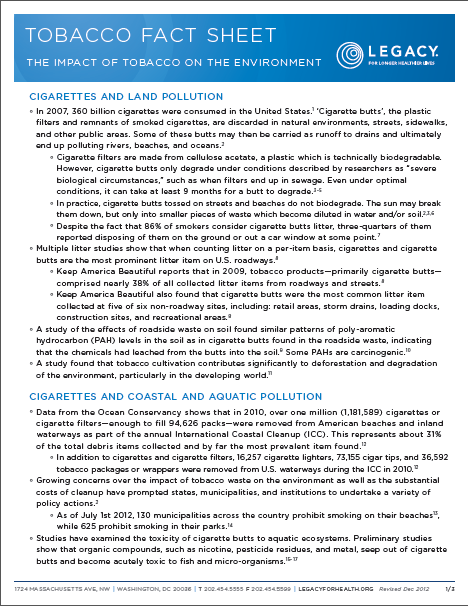
The following is from The Tobacco Fact Sheet
by Legacy For Longer Healthier Lives.
Cigarettes and Land Pollution
° In 2007, 360 billion cigarettes were consumed in the United States.1 ‘Cigarette butts’, the plastic filters and remnants of smoked cigarettes, are discarded in natural environments, streets, sidewalks, and other public areas. Some of these butts may then be carried as runoff to drains and ultimately end up polluting rivers, beaches, and oceans.2
° Cigarette filters are made from cellulose acetate, a plastic which is technically biodegradable. However, cigarette butts only degrade under conditions described by researchers as “severe biological circumstances,” such as when filters end up in sewage. Even under optimal conditions, it can take at least 9 months for a butt to degrade.3–5
° In practice, cigarette butts tossed on streets and beaches do not biodegrade. The sun may break them down, but only into smaller pieces of waste which become diluted in water and/or soil.2,3,6
° Despite the fact that 86% of smokers consider cigarette butts litter, three-quarters of them reported disposing of them on the ground or out a car window at some point.7
° Multiple litter studies show that when counting litter on a per-item basis, cigarettes and cigarette butts are the most prominent litter item on U.S. roadways.8
° Keep America Beautiful reports that in 2009, tobacco products—primarily cigarette butts—
comprised nearly 38% of all collected litter items from roadways and streets.8
° Keep America Beautiful also found that cigarette butts were the most common litter item collected at five of six non-roadway sites, including: retail areas, storm drains, loading docks, construction sites, and recreational areas.8
° A study of the effects of roadside waste on soil found similar patterns of poly-aromatic
hydrocarbon (PAH) levels in the soil as in cigarette butts found in the roadside waste, indicating that the chemicals had leached from the butts into the soil.9 Some PAHs are carcinogenic.10
° A study found that tobacco cultivation contributes significantly to deforestation and degradation of the environment, particularly in the developing world.11

Cigarettes and Coastal and Aquatic Pollution
° Data from the Ocean Conservancy shows that in 2010, over one million (1,181,589) cigarettes or cigarette filters—enough to fill 94,626 packs—were removed from American beaches and inland waterways as part of the annual International Coastal Cleanup (ICC). This represents about 31% of the total debris items collected and by far the most prevalent item found.12
° In addition to cigarettes and cigarette filters, 16,257 cigarette lighters, 73,155 cigar tips, and 36,592 tobacco packages or wrappers were removed from U.S. waterways during the ICC in 2010.12
° Growing concerns over the impact of tobacco waste on the environment as well as the substantial costs of cleanup have prompted states, municipalities, and institutions to undertake a variety of policy actions.2
° As of July 1st 2012, 130 municipalities across the country prohibit smoking on their beaches13, while 625 prohibit smoking in their parks.14
° Studies have examined the toxicity of cigarette butts to aquatic ecosystems. Preliminary studies show that organic compounds, such as nicotine, pesticide residues, and metal, seep out of cigarette butts and become acutely toxic to fish and micro-organisms.15-17
° In one laboratory study, the chemicals that leached from a single cigarette butt soaked in a liter of water for 24 hours released enough toxins to kill 50% of the saltwater and freshwater fish exposed for 96 hours.17
° Another laboratory study found that cigarette butts can be a point source for heavy metal
contamination in water, which may harm local organisms.18
Tobacco Smoke and Air Pollution
° Environmental tobacco smoke (ETS), also known as secondhand smoke is a mixture of smoke given off by the burning end of cigarettes, pipes, cigars, and the smoke exhaled by smokers.19
° In 1986, the U.S. Surgeon General concluded that ETS is a major health risk to nonsmokers. In 1992, ETS was classified as a Group A carcinogen, a substance known to cause cancer.20 In 2006, the Surgeon General concluded that there is no safe level of exposure to ETS.21
° In 2010, 818,580 pounds of toxic chemicals were released into the air by tobacco product manufacturing facilities in the U.S.22 Some of the chemicals released are monitored by the Environmental Protection Agency’s (EPA) Toxic Release Inventory (TRI) database because they are considered hazardous to a person’s health and to the environment.23
° The top five chemicals released were ammonia, nicotine, hydrochloric acid, nitrate compounds, and chlorine.22
Ready to quit smoking?
Are You Still Smoking?
Top 10 Reasons to Quit Smoking























